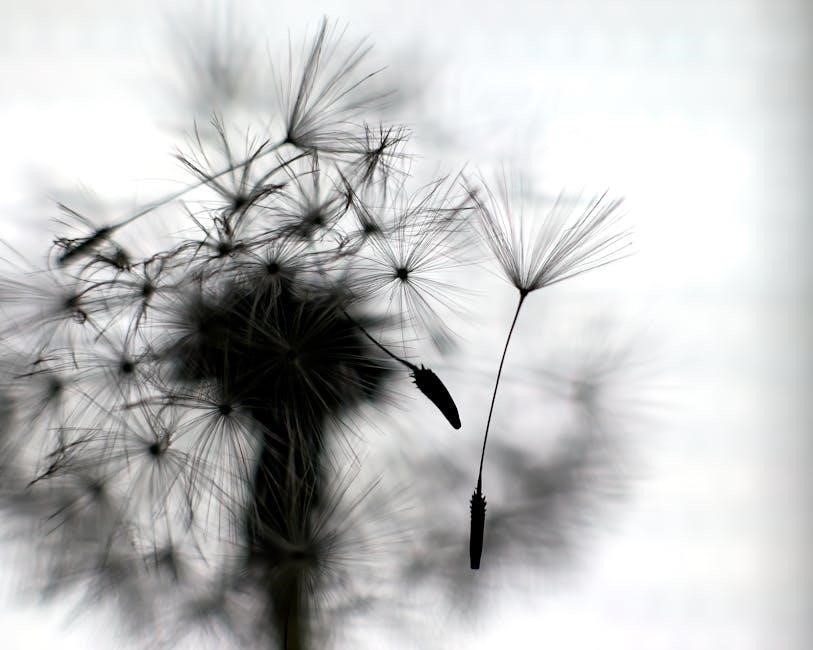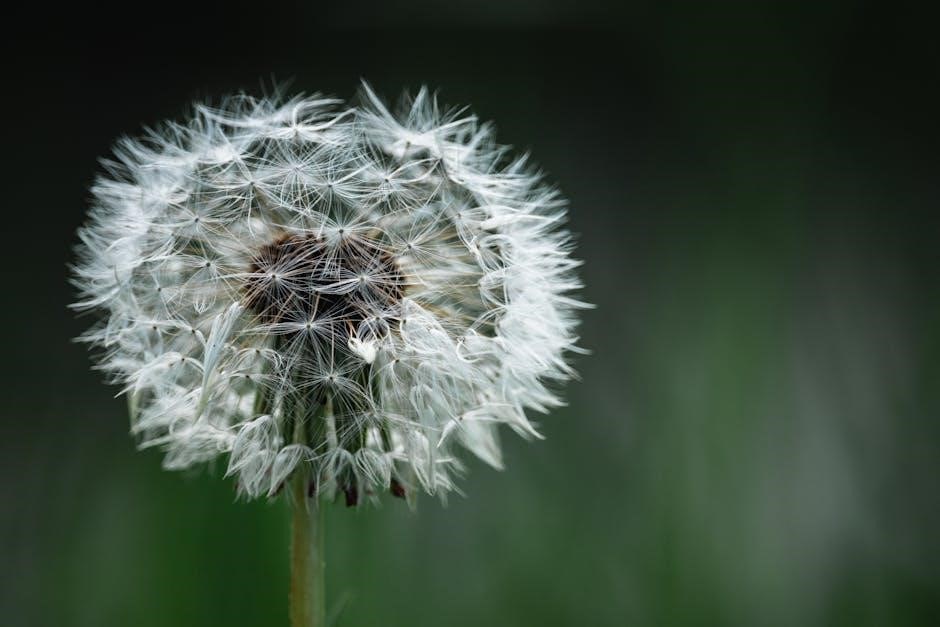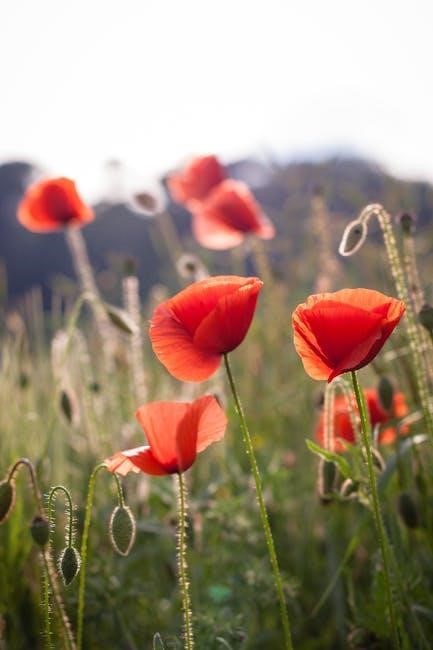Petals on the Wind‚ written by V.C. Andrews in 1980‚ is the second book in the Dollanganger series‚ continuing the dark family saga begun in Flowers in the Attic.
The novel follows the Dollanganger siblings as they escape their traumatic past‚ exploring themes of resilience‚ forbidden love‚ and the haunting legacy of their family’s secrets.
Overview of the Book
Petals on the Wind‚ the second installment in V.C. Andrews’ Dollanganger series‚ delves into the lives of the Dollanganger siblings as they navigate the aftermath of their harrowing experiences in Flowers in the Attic.
The story follows Cathy‚ Christopher‚ and Carrie as they attempt to rebuild their lives‚ grappling with psychological trauma‚ forbidden love‚ and a deep-seated desire for revenge against their mother‚ Olivia.
Set between 1960 and 1975‚ the novel explores themes of family dysfunction‚ resilience‚ and the lasting impact of their dark past.
The book also introduces Dr. Paul Sheffield‚ who becomes a pivotal figure in Cathy’s life‚ offering her a chance at redemption and healing.
With its gripping narrative and emotional depth‚ Petals on the Wind captivates readers‚ further solidifying the Dollanganger saga’s place in literary history.
A TV movie adaptation in 2014 brought the story to life‚ enhancing its cultural impact and appeal to new audiences.
Importance of the Topic
Petals on the Wind holds significant cultural and literary value as a sequel to Flowers in the Attic‚ exploring themes of trauma‚ revenge‚ and forbidden love.
Its portrayal of family dysfunction and psychological scars resonates deeply with readers‚ making it a pivotal work in the Dollanganger series.
The novel’s exploration of complex human emotions and dark secrets has captivated audiences‚ solidifying its place in popular culture.
Additionally‚ the book’s adaptation into a TV movie in 2014 further highlights its enduring appeal and relevance to modern audiences.
Examining Petals on the Wind provides insights into the human condition‚ making it a compelling subject for both casual readers and academic analysis.
Structure of the Article
This article delves into the compelling narrative of Petals on the Wind‚ examining its intricate plot‚ character development‚ and enduring themes. The structure is divided into several key sections: an introduction to the novel‚ background information about the author and series‚ a detailed plot summary‚ an exploration of major characters‚ an analysis of themes and symbols‚ the book’s reception and reviews‚ its adaptations into other media‚ and academic insights. Each section provides in-depth analysis‚ ensuring a comprehensive understanding of the novel’s significance and impact. By exploring these elements‚ the article offers a thorough examination of why Petals on the Wind remains a captivating read.

Background Information
Petals on the Wind‚ the second book in the Dollanganger series‚ explores the dark legacy of the Dollanganger family‚ delving into themes of trauma‚ revenge‚ and forbidden love‚ set against a backdrop of secrecy and family dysfunction.

About the Author: V.C. Andrews
V.C. Andrews was a renowned American author‚ best known for her gripping novels in the gothic and family drama genres. Born as Cleo Virginia Andrews‚ she rose to fame with her debut novel‚ Flowers in the Attic‚ which became a cultural phenomenon. Andrews’ writing often explored themes of forbidden love‚ family secrets‚ and psychological trauma‚ captivating readers worldwide. Her distinctive style‚ blending emotional depth with intense storytelling‚ solidified her legacy in contemporary literature. Despite her untimely death in 1986‚ her work continues to be widely read‚ with posthumous publications and adaptations ensuring her enduring influence on popular culture and the literary world.
The Dollanganger Series

The Dollanganger series‚ written by V.C. Andrews‚ is a captivating saga that explores the dark and intricate lives of the Dollanganger family. The series begins with Flowers in the Attic‚ where four siblings are locked in an attic by their manipulative grandmother. Petals on the Wind follows their escape and struggle to rebuild their lives‚ while grappling with revenge and psychological scars. The series continues with If There Be Thorns and Seeds of Yesterday‚ delving into themes of family dynamics‚ forbidden love‚ and the lingering effects of trauma. The Dollanganger series is renowned for its emotional depth and shocking plot twists‚ making it a beloved yet haunting read for millions of fans worldwide.
Historical Context of the Novel
Petals on the Wind is set against the backdrop of the 1960s and early 1970s‚ a time of social and cultural upheaval in America. The novel reflects the changing attitudes toward family dynamics‚ gender roles‚ and mental health during this period. The story’s focus on trauma‚ revenge‚ and forbidden love resonates with the era’s exploration of psychological and emotional complexities. The setting‚ spanning locations such as Virginia and New York City‚ also highlights the contrasts between traditional Southern values and the progressive urban environments of the time. This historical context enriches the narrative‚ providing a vivid backdrop for the Dollanganger siblings’ struggles and their quest for redemption.

Plot Summary
Petals on the Wind follows the Dollanganger siblings as they rebuild their lives after escaping Foxworth Hall. Cathy pursues ballet and revenge‚ while family secrets persist‚ fueling their quest for justice and healing.
Key Events in the Book
The Dollanganger siblings escape Foxworth Hall‚ seeking refuge with Dr. Paul Sheffield. Cathy is determined to exact revenge on her mother‚ while Chris and Carrie struggle to heal. Cathy’s ballet career flourishes‚ but her obsession with vengeance grows. Tragic events from their past continue to haunt them‚ shaping their futures. The novel explores their journey toward healing and justice‚ intertwined with forbidden love and family secrets.
Character Development
The characters in Petals on the Wind undergo significant transformation‚ driven by their traumatic past. Cathy evolves from a vulnerable girl into a determined woman consumed by revenge‚ while Chris grapples with guilt and loyalty. Carrie‚ the youngest‚ struggles with insecurity and a longing for stability. Dr. Paul Sheffield becomes a stabilizing force‚ offering guidance and support. Their development is marked by internal conflicts‚ as they navigate forbidden love‚ betrayal‚ and the lasting impact of their family’s dark secrets. Each character’s journey reflects their resilience and the psychological scars left by their experiences.
Themes and Motifs
Petals on the Wind explores themes of family dysfunction‚ revenge‚ and forbidden love‚ intertwined with psychological trauma. The motif of the attic symbolizes confinement and the siblings’ unresolved past. Forbidden love‚ particularly between Cathy and Christopher‚ underscores the moral ambiguity and societal taboos they confront. Revenge becomes a driving force‚ especially for Cathy‚ as she seeks to confront her mother and grandmother for their cruelty. The novel also delves into the fragility of innocence‚ symbolized by the petals in the wind‚ representing the scattering of their childhood and the loss of security. These themes are woven together to create a haunting narrative of resilience and the enduring impact of family secrets.

Major Characters
Cathy Dollanganger‚ the strong-willed protagonist‚ seeks revenge and grapples with forbidden love. Christopher faces moral dilemmas and a complex bond with Cathy. Carrie yearns for stability‚ while Dr. Paul Sheffield offers refuge and guidance.
Cathy Dollanganger
Cathy‚ a resilient and fiery protagonist‚ drives the narrative with her quest for vengeance against her mother. Her journey is marked by emotional turmoil‚ as she struggles with forbidden love for her brother Christopher. Cathy’s determination to rebuild her life is tested by her deep-seated anger and desire to expose the truth. Her complex relationship with Dr. Paul Sheffield adds depth to her character‚ showcasing her strength and vulnerability. Through her‚ V.C. Andrews explores themes of resilience‚ revenge‚ and the enduring impact of childhood trauma. Cathy’s evolution from a victim to a survivor underscores her central role in the story.
Christopher Dollanganger
Christopher‚ the older brother of Cathy and Carrie‚ is a central figure in Petals on the Wind. His bond with Cathy is deeply emotional‚ reflecting their shared traumatic experiences. After escaping Foxworth Hall‚ Christopher strives to rebuild his life‚ pursuing a career as a doctor. His internal conflict arises from his forbidden love for Cathy‚ which haunts him throughout the story. Christopher’s character embodies resilience and determination‚ as he attempts to heal not only himself but also his fractured family. His journey highlights the lasting psychological scars of their past and his struggle to find redemption and happiness. Christopher’s role is pivotal in exploring themes of forbidden love and familial bonds.
Carrie Dollanganger
Carrie‚ the youngest sibling‚ plays a poignant role in Petals on the Wind. Her fragile health and innocent demeanor make her a symbol of vulnerability. Carrie’s desire for stability and love drives her actions‚ as she seeks a sense of belonging after the trauma of the attic. Her character highlights the lasting emotional scars of their past‚ as she struggles to adapt to a world outside Foxworth Hall. Carrie’s journey underscores themes of family dynamics and psychological trauma‚ showcasing her resilience and the deep bonds she shares with her siblings. Her story adds depth to the exploration of healing and the quest for normalcy in the face of overwhelming adversity.
Dr. Paul Sheffield
Dr. Paul Sheffield is a pivotal character in Petals on the Wind‚ offering refuge and support to the Dollanganger siblings after their traumatic experiences. His home provides a sense of stability and safety‚ allowing Cathy‚ Chris‚ and Carrie to begin healing. Paul’s kindness and understanding play a crucial role in their recovery‚ especially for Cathy‚ who gravitates toward him as a source of comfort. His relationship with Cathy evolves into a deep emotional bond‚ though it remains complicated due to her inner turmoil and unresolved feelings for her brother. Paul’s presence highlights themes of trust‚ healing‚ and the quest for a normal life‚ making him a key figure in their journey toward redemption and forgiveness. His influence shapes their ability to confront their past and rebuild their futures. Paul’s character underscores the importance of external support in overcoming psychological trauma‚ offering a beacon of hope amidst their struggles. His role in the story is both nurturing and complex‚ adding depth to the narrative of the Dollanganger siblings’ resilience and growth. Dr. Paul Sheffield’s impact on the characters and the plot is significant‚ as he represents a chance for them to break free from their haunting legacy and find a path toward healing and love. Through his interactions with the siblings‚ Paul embodies the themes of family dynamics and psychological recovery‚ providing a stabilizing force in their lives. His character serves as a catalyst for their emotional journeys‚ helping them navigate the challenges of their past while striving for a brighter future. Dr. Paul Sheffield’s role in Petals on the Wind is both compassionate and transformative‚ making him an essential part of the story’s emotional landscape.

Themes and Symbols
Central themes include forbidden love‚ revenge‚ and family dysfunction‚ while symbols like the attic and petals represent confinement‚ trauma‚ and the fragility of hope.
Forbidden Love
Forbidden love is a central theme in Petals on the Wind‚ particularly through Cathy and Christopher’s incestuous relationship‚ rooted in their traumatic isolation in the attic; Their bond‚ forged in secrecy and survival‚ blurs the lines of sibling affection and romantic desire. Cathy’s beauty and charm also attract other men‚ symbolizing her struggle for control in a world where her past defines her. The novel explores the emotional turmoil and societal taboos surrounding such relationships‚ highlighting the lasting psychological scars and the characters’ inability to escape their dark history. This theme underscores the destructive power of unresolved trauma and the blurred boundaries between love and obsession.
Revenge and Forgiveness
Revenge and Forgiveness are intertwined themes in Petals on the Wind‚ driven by the siblings’ traumatic experiences in the attic. Cathy’s relentless pursuit of vengeance against her mother and grandmother fuels her actions‚ while her internal struggle with forgiveness reflects the emotional scars left by their abuse. The novel explores how the desire for revenge consumes her‚ complicating her relationships and decisions. Meanwhile‚ the possibility of forgiveness offers a path toward healing‚ yet the weight of their past makes it difficult to reconcile. This duality highlights the psychological complexity of the characters and the lasting impact of their suffering‚ leaving readers questioning whether true forgiveness is achievable;
Family Dynamics
Family Dynamics in Petals on the Wind are deeply fractured‚ shaped by the siblings’ traumatic past and their struggle to rebuild their lives. The novel portrays the intense bond between Cathy‚ Chris‚ and Carrie‚ forged through their shared suffering in the attic. Their relationships are marked by loyalty and mutual dependence‚ yet also strained by secrets and unspoken tensions. The absence of parental love and the manipulative influence of their mother and grandmother further distort their sense of family. As they navigate their new lives‚ the siblings grapple with trust issues and conflicting desires‚ highlighting the enduring impact of their dysfunctional family history on their ability to form healthy relationships.
Psychological Trauma
Psychological Trauma is a pervasive theme in Petals on the Wind‚ as the Dollanganger siblings grapple with the emotional scars of their oppressive past. The horrors of the attic‚ including isolation‚ abuse‚ and loss‚ leave lasting mental wounds. Cathy’s bitterness and desire for revenge stem from unresolved trauma‚ while her complicated relationships reflect deep-seated emotional pain. Carrie’s struggles with guilt and self-worth highlight the long-term effects of their suffering. The novel portrays how trauma shapes their identities and hinders their ability to trust or form healthy connections‚ underscoring the enduring impact of their experiences on their mental well-being and relationships.

Reception and Reviews
Petals on the Wind received mixed reviews but remained a bestseller‚ praised for its emotional depth and gripping narrative. Critics noted its dark themes and intense character dynamics.
Critical Response
Critics noted Petals on the Wind’s emotional depth and gripping narrative. The exploration of forbidden love and family secrets was praised‚ though some found the themes overly dark and intense.
Public Reception
Readers embraced Petals on the Wind‚ drawn to its dramatic continuation of the Dollanganger saga. Fans praised the book’s ability to evoke strong emotions and maintain suspense‚ solidifying its place as a beloved sequel in the series.
Comparisons with “Flowers in the Attic”
Readers frequently compare Petals on the Wind to its predecessor‚ Flowers in the Attic‚ noting its darker and more intense tone. While the first book focused on the siblings’ confinement‚ the sequel explores their struggle to rebuild lives marked by trauma. Fans often debate which book is more compelling‚ with some preferring the original’s shocking premise and others appreciating the deeper character development in Petals. The sequels ability to maintain the series’ signature emotional depth has solidified its place as a worthy follow-up.

Adaptations and Media
Petals on the Wind was adapted into a successful TV movie in 2014‚ continuing the legacy of the Dollanganger series and further popularizing the novel.
TV Movie Adaptation
Petals on the Wind was adapted into a TV movie in 2014‚ serving as the sequel to the successful Flowers in the Attic film. The movie follows Cathy‚ Christopher‚ and Carrie as they attempt to rebuild their lives after escaping Foxworth Hall. Starring Rose McIver as Cathy and Wyatt Nash as Christopher‚ the film explores themes of forbidden love‚ revenge‚ and the lingering psychological scars from their traumatic past. The adaptation remained faithful to the novel’s core‚ delving into the complexities of the siblings’ relationships and their struggles to find normalcy. It also highlighted the dark legacy of their family’s secrets‚ resonating with fans of the book series.
Impact on Popular Culture
Petals on the Wind has left a lasting imprint on popular culture‚ particularly in the genre of dark family dramas. Its exploration of taboo themes and complex relationships has influenced numerous adaptations and inspired similar narratives in literature and film. The novel’s success led to a dedicated fan base‚ with discussions and analyses thriving in online communities. The TV movie adaptation further amplified its reach‚ introducing the story to new audiences. Its enduring popularity highlights its ability to captivate readers and viewers alike‚ solidifying its place as a cultural touchstone in the realm of dramatic storytelling. Its influence continues to resonate‚ making it a landmark in modern literature.

Academic Analysis
Scholars have analyzed Petals on the Wind for its psychological insights into trauma and its sociological commentary on family dynamics‚ offering a deeper understanding of its themes.
Psychological Insights
Petals on the Wind offers profound psychological insights into the trauma experienced by the Dollanganger siblings‚ particularly Cathy‚ whose desire for revenge dominates her actions.
The novel explores the lasting effects of isolation‚ abuse‚ and family dysfunction‚ revealing how these experiences shape their mental health and relationships.
Cathy’s fixation on vengeance‚ coupled with her complex emotions toward her brother Christopher‚ highlights the blurred lines between love and resentment‚ showcasing the psychological turmoil of the characters.
The story delves into themes of resilience and the struggle to heal‚ providing a gripping examination of the human psyche in the face of extreme adversity.
Through these themes‚ V.C. Andrews masterfully illustrates the long-term consequences of childhood trauma and the enduring impact of familial secrets.
Sociological Perspectives
Petals on the Wind provides a sociological lens into the oppressive family dynamics and societal expectations of the 1960s and 1970s‚ highlighting the constraints placed on women and marginalized groups.
The novel critiques the rigid class structures and the pursuit of wealth‚ as seen through the Foxworth family’s obsession with inheritance and status‚ which drives their morally questionable actions.
It also explores the stigma surrounding illegitimacy and unconventional relationships‚ reflecting the societal judgment faced by characters like Cathy and her siblings due to their traumatic past and family secrets.
By portraying these themes‚ V.C. Andrews sheds light on the societal pressures that shape individual choices and the enduring impact of cultural norms on personal lives.
Literary Criticism
Petals on the Wind has been analyzed for its exploration of family dynamics‚ revenge‚ and psychological trauma‚ with critics noting its intense emotional narrative and gothic undertones.
The novel is praised for its vivid characterization‚ particularly the complex and often controversial portrayal of Cathy‚ whose evolution from victim to avenger sparks debate.
Some critics argue that the melodramatic elements and sensational plot overshadow deeper thematic exploration‚ while others highlight its compelling examination of the long-term effects of trauma.
Overall‚ the book remains a significant work in the genre‚ offering insights into the human condition through its dark and intricate storytelling.
Petals on the Wind leaves a lasting impact with its exploration of love‚ revenge‚ and family dynamics‚ cementing its legacy as a gripping sequel in the Dollanganger series.
Final Thoughts
Petals on the Wind captivates readers with its dark‚ emotional journey‚ delving into themes of revenge‚ love‚ and family secrets. The novel’s exploration of psychological trauma and resilience leaves a lasting impression‚ making it a memorable sequel to Flowers in the Attic. The complex characters‚ particularly Cathy’s evolution‚ drive the story’s intensity. While some critics note its heavy focus on melodrama‚ fans praise its ability to evoke strong emotions. The book’s legacy endures‚ solidifying its place in the Dollanganger series and V.C. Andrews’ oeuvre.
Legacy of the Book
Petals on the Wind has left an indelible mark on the literary world‚ solidifying its place as a gripping sequel in the Dollanganger series. Its exploration of dark family secrets and forbidden love continues to captivate readers. The novel’s success led to a TV movie adaptation‚ further cementing its impact on popular culture. As part of V.C. Andrews’ enduring legacy‚ Petals on the Wind remains a timeless tale of resilience and revenge. Its enduring popularity is a testament to its ability to evoke raw emotions and spark reflection on family dynamics and psychological trauma.
